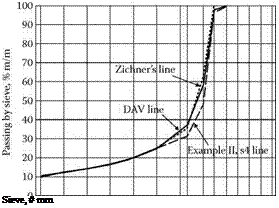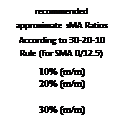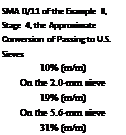Comparison of Results of Example II with the 30-20-10 rule of SMA Composition
According to the rule described in Section 6.2.2, proper stone-to-stone contact is created if the percentage of aggregate passing the 0.075 mm, 2.36 mm, and
4.75 mm sieves equals 10%, 20%, and 30%, respectively. Table 6.11 shows the comparison between the achieved result of Stage 4 and ratios according to the 30-20-10 rule.
There are some noticeable differences. First, the 30-20-10 SMA should contain more aggregates larger than 2.36 mm (80%), whereas the relevant SMA of Example I was designed at only 75% on the 2.0 mm sieve. With regard to particles larger than
Recommended Ratios of SMA 0/11S according to German DAV Handbook Compared with the result of sMA design in example ii
|
TABLE 6.10
a See Table 6.4. b From Druschner, L., Schafer, V., Splittmastixasphalt. DAV Leitfaden. Deutscher Asphaltverband, 2000. |
0
 10
10
![]() 20
20
30
40
50
60
70
80
90
100
FIGURE 6.8 SMA mix of Example II, Stage 4, adjusted to the ratios recommended by the German DAV handbook compared with its original gradation and Zichner’s proportions.
 |
 |
 |
|
4.75 mm, the result obtained in Example II is consistent with the requirement concerning 30%. Figure 6.9 shows the SMA corrected in such a way that its ratios are in conformity with the assumptions of the 30-20-10 rule.
The SMA designed according to the 30-20-10 rule is more gap graded than our SMA in Example II, which is especially evident in the percent passing the 2.0-mm sieve. In general, mixtures with such a strong gap in grading are harder to compact and are more permeable. On the other hand, one can get very strong skeleton with such a clear gap grading (stone-to-stone contact).






Leave a reply